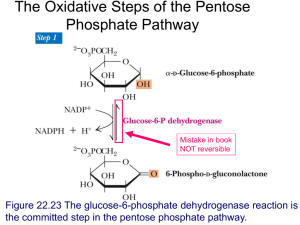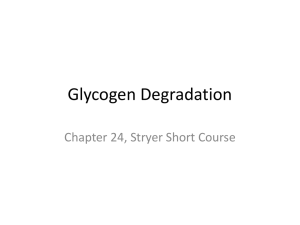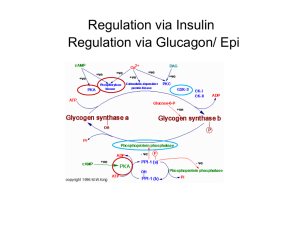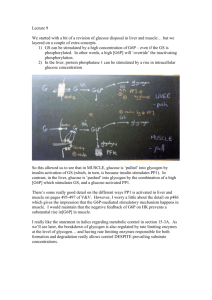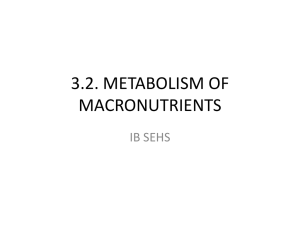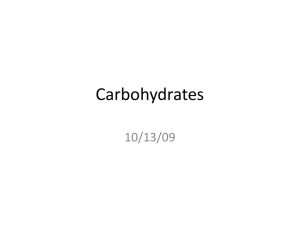Glycogen Metabolism
advertisement
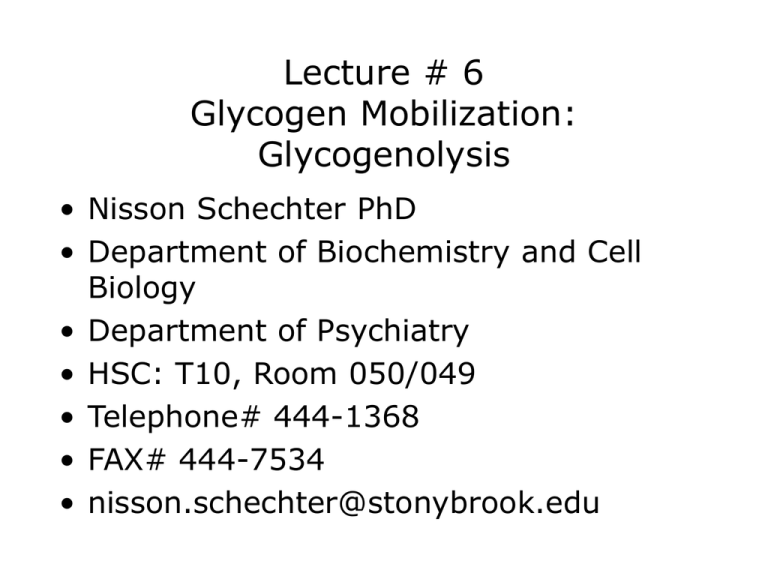
Lecture # 6 Glycogen Mobilization: Glycogenolysis • Nisson Schechter PhD • Department of Biochemistry and Cell Biology • Department of Psychiatry • HSC: T10, Room 050/049 • Telephone# 444-1368 • FAX# 444-7534 • nisson.schechter@stonybrook.edu Glycogen Mobilization: Glycogenolysis • Stryer: Chap. 21/pp, 577- 598. • Lehninger: Chap. 15/pp, 547- 557. • Marks : Chap. 26/pp, 407- 422. Chap. 31/pp, 471 - 485. Glycogen Mobilization: Glycogenolysis • Glycogenolysis is a catabolic process; the breakdown of glycogen to glucose units. • Glycogen is principally stored in the cytosol granules of – Liver – Muscle Liver Cell Glycogen Function • In liver – The synthesis and breakdown of glycogen is regulated to maintain blood glucose levels. • In muscle - The synthesis and breakdown of glycogen is regulated to meet the energy requirements of the muscle cell. Glucose 6-phosphate has 3 fates. The α-1,4-linkage predominates. Synthesis requires the addition of glucose to the nonreducing ends of glycogen via UDP-glucose. Glycogen phosphorylase catalyzes the breakdown of glycogen. Glycogen + Pi Glucose 1- phosphate + glycogen (n residues) (n-1 residues) A note on the energetics. • The reaction is reversible • It proceeds to the right (breakdown) because [Pi]/[glucose 1-phosphate ratio > 100. • Notice the release sugar is already phosphorylated. No investment of ATP is required and can enter glycolysis directly. • The phosphorylated product (glucose 1phosphate) can not leave the cell. Phosphorylase is specific for the α-1,4 linkage. Two additional enzymes are required. Linear molecule is created. Shifts 3 glycosyl units to the core. Hydrolyzes the single 1,6 glucose unit to free glucose. Hexokinase →glu.6-P Note! • In eukaryotes the transferase activity and the α-1,6-glucosidase activity are within one bifunctional protein. • The glucose 1-phosphate to converted to glucose 6-phosphate by phosphoglucomutase. Glucose 6-phosphate has 3 fates. Remember! • Liver contains glucose 6-phosphatase. • Muscle does not have this enzyme. WHY? The liver releases glucose to the blood to be taken up by brain and active muscle. The liver regulates blood glucose levels. The muscle retains glucose 6-phosphate to be use for energy. Phosphorylated glucose is not transported out of muscle cells. Pyridoxal phosphate is the coenzyme for phosphorylase. The active site is hydrophobic. Phosphorylation of glucose without ATP. Glycogen phosphorylase uses pyridoxal phosphate (PLP) a derivative of pyridixine (vitamine B6) as a coenzyme. B6 is required for the mobilization of glucose from glycogen. It is also required for other biochemical reactions such as transamination. Phosphorylase is an allosteric enzyme. Active Inactive • Each of the two forms are in equilibrium between an active relaxed (R) state and less active (T) state. • The equilibrium for phosphorylase a favors the R state (active). • The equilibrium for phosphorylase b favors the T state (less active). • Phosphorylase b is converted to Phosphorylase a (active) with the phosphorylation of serine 14 by the enzyme phosphorylase kinase. The Bottom Line • Phosphorylase kinase converts phosphorylase b inactive to phosphorylase a active. • The T state is less active because the active site is partially blocked. • The R state is active because the active site is exposed. Each of the two forms are in equilibrium between an active relaxed (R) state and less active (T) state. The equilibrium for phosphorylase a favors the R state. The equilibrium for phosphorylase b favors the T state. Muscle In Muscle • High [AMP] shifts the equilibrium to the active R state. – The muscle cell has a low energy charge. • High [ATP] and [glucose 6-phosphate] shifts the equilibrium to the less active T state. • So the energy charge in muscle cells regulates the transition between T and R states for phosphorylase b. In Muscle • Phosphorylase b predominates. • In resting muscle phosphorylase b is in the inactive T state. • With exercise the increase [AMP] shifts the equilibrium to the active R state. • Exercise will also stimulate the hormone epinephrine which will convert phosphorylase b to phosphorylase a. In Liver - A different story • Glucose shifts the phosphorylase to the T state, deactivating the enzyme. • Glucose is a negative regulator of liver Phosphorylase. – Glucose is not mobilized when glucose is abundant. • Liver phosphorylase is insensitive to AMP. – Liver does not exhibit dramatic changes in energy charge as in contracting muscle. Liver slightly different aa sequence than muscle Fully active phosphorylase kinase requires Ca++ and a phosphate. protein kinase A Epinephrine and Glucagon Stimulate Glycogen breakdown • Muscle is responsive to epinephrine. • Liver is responsive to glucagon and somewhat responsive to epinephrine. • Both signal a cascade of molecular events leading to glycogen breakdown. • Both utilize a G-protein-dependent signal-transduction pathway. A few hormone molecules cause the release of large amounts of glucose, a cascade. Glycogenesis The Synthesis of Glycogen An Energy Consuming Pathway Glycogenesis • Glycogen is synthesized via uridine diphosphate glucose (UDP – glucose). • Synthesis: Glycogenn + UDP-glucose → glucogenn+1 + UDP. • Degradation: glucogenn + Pi → Glycogenn-1 + glucose 1-phosphate. Glycogen synthesis and degradation utilize separate pathways. Luis Leloir Nobel Prize in Chemistry, 1970 “ for his discovery of sugar nucleotides and their role in the biosynthesis of carbohydrates” UDP glucose is the activated form of glucose. Acetyl CoA is the activated form of acetate. AA-tRNA is the activated form of amino acids. UDP-glucose pyrophosphorylase Glucose 1-phosphate + UTP UDP-glucose + PPi. ppi + H2O → 2Pi. Glucose 1-phosphate + UTP + H2O → UDP-glucose + 2Pi. Although the reaction is reversible the hydrolysis of the pyrophosphate pushes it to the right. Glycogen synthase catalyzes α-1,4 linkages A primer of a least 4 units are required via glycogenin. Glucose is added to the non-reducing end. UDP Branching enzyme forms α-1,6 linkages: Remodeling The enzyme breaks the α-1,4 link and forms a α1,6 link. A large number of terminal residues are now available for glycogen phosphorylase; degradation. Branching increases the solubility of glycogen. Glycogen synthase is the regulatory enzyme in the synthesis of glycogen. The enzyme is regulated by covalent modification; phosphorylation. Regulation of Glycogen Synthase • When the enzyme is phosphorylated, it is inactivated. – Active “a” form to inactive phosphorylated “b” form. • Notice that phosphorylation has the opposite effect on glycogen phosphorylase; phosphorylation activates. Glycogen synthesis Glucose 6-P→ glucose 1-P. glucose 1-P + UTP→UDP-glucose + PPi. PPi + H2O→ 2 Pi. UDP-glucose + glycogenn → glycogenn+1. UDP + ATP → UTP + ADP. Glucose 6-P + ATP + glycogenn + H2O → glycogenn+1 + ADP + 2Pi. Only one ATP is used to store one glucose residue in glycogen. (nucleoside diphosphokinase) Glycogen synthesis and breakdown are reciprocally regulated Red=inactive forms, green = active forms. Active Protein phosphatase 1 (PP1) regulates glycogen metabolism. Inactive Protein Phosphatase 1 • PP1 dephosphorylates phosphorylase kinase and phosphorylase a, thus inactivating glycogenolysis. • PP1 also dephosphorylates glycogen synthase b, thus activating glycogen synthesis. PP1 dephosphorylates phosphorylase kinase and phosphorylase a thus inactivating glycogenolysis. PP1 dephosphorylates glycogen synthase b thus activating glycogen synthesis • When blood glucose levels are high, insulin activates protein phosphatase 1 which stimulates glycogen synthesis. – This is accomplished through a complex highly regulated signal transduction pathway. • Remember: Glycogen metabolism in liver regulates blood glucose levels. Blood glucose levels rise after ingestion of carbohydrates, leading to glycogen synthesis. Inactivation of phosphorylase and an activation ofglycogen synthase. Liver Besides insulin, glucose itself binds to phosphorylase a. PP1 acts as a catalyst only when phosphorylase a is in the T state. The conversion of ab releases PP1 to activate glycogen synthase. In liver inhib inact. When blood glucose is high. When PP1 is free. Muscle phosphorylase a is unaffected by glucose. act. A Take Home Lesson! • Glucogon = starved state; stimulates glycogen breakdown, inhibits glycogen synthesis. • High blood glucose levels = fed state; insulin stimulates glycogen synthesis and inhibits glycogen breakdown.
